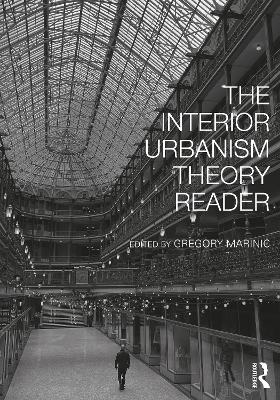
The Interior Urbanism Theory Reader
Routledge (Verlag)
978-1-138-33630-8 (ISBN)
The Interior Urbanism Theory Reader expands our understanding of urbanism, interiority, and publicness from a global perspective across time and cultures.
From ancient origins to speculative futures, this book explores the rich complexities of interior urbanism as an interstitial socio-spatial condition. Employing an interdisciplinary lens, it examines the intersectional characteristics that define interior urbanism. Fifty chapters investigate the topic in relation to architecture, planning, urban design, interior architecture, interior design, archaeology, engineering, sociology, psychology, and geography. Individual essays reveal the historical, typological, and morphological origins of interior urbanism, as well as its diverse scales, occupancies, and atmospheres.
The Interior Urbanism Theory Reader will appeal to scholars, practitioners, students, and enthusiasts of urbanism, architecture, planning, interiors, and the social sciences.
Gregory Marinic, PhD, is an Associate Professor in the University of Cincinnati College of Design, Architecture, Art, and Planning. He is the Director of URBANIA, a grant-funded research lab that speculates on metropolitan futures with current research focused on housing, urban design, urban morphology, and informal settlements. Prior to academia, he worked in architecture firms in New York and London, including Rafael Vinoly Architects, Gensler, Tsao & McKown Architects, Yoshihara McKee Architects, and ABS Architects. At Vinoly, he contributed to RIBA and AIA award-winning civic, academic, performing arts, residential, aviation, urban design, master planning, and international competition projects. His New York-based multidisciplinary design practice, Arquipelago, has been awarded by the Seoul Metropolitan Government, American Institute of Architects, and Association of Collegiate Schools of Architecture, as well as exhibited in the AIA Center for Architecture in New York, AIA Center for Architecture and Design in Philadelphia, Estonian Architecture Museum in Tallinn, Dongdaemun Design Plaza in Seoul, TSMD Architecture Center in Ankara, and National Building Museum in Washington, DC.
PART 1: HISTORIES & TYPOLOGIES 1. The Arcade 2. The Street 3. The Megablock 4. The Laneway 5. The Bazaar 6. The Platform City 7. The Skywalk 8. The Atrium 9. The Subway 10. The Railway Station 11. The Government Center 12. The Library 13. The Museum 14. The Department Store 15. The Shopping Mall 16. The Supermarket 17. The Hotel 18. The Cruise Ship PART 2: THEORIES & INFLUENCES Inhabitation 19. Interiorized Urbanism: Inhabiting the City between Mobility and Domestication 20. The Roman Domus: Interior Urbanism at a Domestic Scale 21. Public Urban Interiors 22. Intimate Inhabitation: Toward an Intercourse of Creaturely Urbanism Threshold 23. Inside-Out and Outside-In: Projecting the Idea of the Urban Theater 24. Permeability and the Urban Interior 25. When the Whole Neighborhood Becomes Home: Domestic Interiors of an Urban Kampung 26. Contextualizing and Politicizing the Urban Public Interiors of Istanbul 27. Shopping Spaces in the East and West Culture 28. New Interior Identities: Inhabiting London’s Railway Stations, Winter Gardens, People’s Palaces, and Department Stores, 1830-1920 29. Arcading Cleveland: From Continental Europe to America 30. Canadian Academic Interior Urbanism as a Climatic and Cultural Response 31. Bedouin Women Sellers and Kuwait’s Souk Wajif 32. Performative Activators: Interior Urbanism and the Spaces of Cultural Production Identity 33. Queering the Urban Room: Toward a Resilient Urban Design Praxis 34. Sacred Adsorptions: Civic Sites for (Gendered) Public Mourning in Yazd, Iran 35. How Home Creates Us: Femininity, Memory, and Domestic Space 36. Transient Interiorities: Space, Gender, and Bucharest Street Culture 37. Bathhouse Memories Temporality 38. Chimeric City: Liminal Spaces of Indian Night Markets 39. Imagination as an Act: Extended Realities in Interior Urbanism 40. Sound Mind: Media and Mediations of Interior Soundscapes 41. Fluid Interfaces Vastness 42. Brutalist Interior Urbanism: Visions, Paradigms, Design Strategies 43. A Paradoxical Imago Mundi: The No-Stop City by Archizoom Associati 44. Seoul, Underground City 45. Lower West Side Story: The World Trade Center and the Interior Masterplan Speculation 46. A Theory of Origin: A Proto-typology of Interior Urbanism 47. Urban Interior Networks 48. Envisioning the Future of Interior Urbanism 49. The Subjective City: Towards a Reconceptualization of Urban Interiority 50. A Brief Allegory of Capitalism in the Time of Plague
| Erscheinungsdatum | 14.03.2024 |
|---|---|
| Zusatzinfo | 18 Line drawings, black and white; 133 Halftones, black and white; 151 Illustrations, black and white |
| Verlagsort | London |
| Sprache | englisch |
| Maße | 174 x 246 mm |
| Gewicht | 1034 g |
| Themenwelt | Kunst / Musik / Theater ► Design / Innenarchitektur / Mode |
| Naturwissenschaften ► Biologie ► Ökologie / Naturschutz | |
| Technik ► Architektur | |
| ISBN-10 | 1-138-33630-0 / 1138336300 |
| ISBN-13 | 978-1-138-33630-8 / 9781138336308 |
| Zustand | Neuware |
| Informationen gemäß Produktsicherheitsverordnung (GPSR) | |
| Haben Sie eine Frage zum Produkt? |
aus dem Bereich


